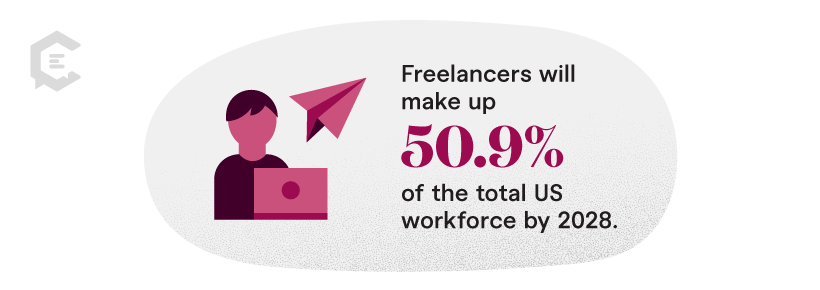For many freelancers, going freelance has been one of the most rewarding decisions they’ve ever made. They can work from anywhere, choose their clients and the types of contract work to accept, set their own work hours, and spend more time with their families.

Data from Fiverr estimated that approximately 73 percent of US workers would “either start or continue to work in a freelance capacity” in 2023, while research from Statista forecasts that freelancers will make up 50.9 percent of the total US workforce in 2028. Meanwhile, the global freelance platform market is expected to expand to an annual growth rate of 16.5 percent, a projected value of USD 14.39 billion, by 2030.
Freelancing definitely has its perks, but for target clients to know what you’re offering, you always have to be marketing. To be able to raise your rates and not live from paycheck to paycheck, you always have to be adept at freelancer self-promotion. You must always be marketing to stand out in an increasingly competitive marketplace.
But what if you dread self-promotion? You’re not alone. But as personal branding professionals love to say, if you don’t tell your story, someone else will — and it may not be the story you want to tell. Even if freelancer marketing sometimes feels fruitless, getting the word out about your services — consistently, thoughtfully, and in a manner that aligns with your vision and values — is a proven way to build a steady client pipeline.
The Fundamentals of Building Your Freelance Brand
Trust is foundational to any kind of business relationship. And freelancer self-promotion isn’t just about showcasing your work or expertise. It’s also about crafting a relatable personal brand. Clients who feel a personal connection to you and what you represent are more likely to consider your services.
So, how do you get started building your brand? Here are some tips:
Identify your unique value proposition (UVP)
Your unique value proposition is what sets you apart from other freelancers. It states the benefit of your offer, how you solve client problems, and what makes you different from others offering the same services.
To find your UVP, consider your experiences, strengths, and special skills. What do past clients say about you? What unique qualities do you possess that made them hire you over others?
Know your audience
“If you market to everyone, you market to no one” is a marketing mantra to live by. Focus on a specific niche or demographic. This way, you can tailor your messaging, services, and marketing strategies to resonate with the types of clients or industries where you can provide the most value.
Communicate your mission and values
Mission statements aspire to rally people around a common goal. And they’re not just for corporations — they’re for small businesses and freelancers, too.
A mission statement communicates what you do, won’t do, why you do what you do, and the values that guide your work. It’s first and foremost for you — to guide the decisions you make, but it can also attract clients who share similar values.
Create a consistent visual identity across platforms
To build brand recognition, ensure that your visual and design elements — logo, color scheme, typography, and imagery — are the same everywhere. This way, your target audience can recognize your brand no matter where they see it, whether on social media, your website, or business cards.
Share your journey
Use storytelling to narrate how you got to where you are today. People love good stories; a relatable, authentic story can make you memorable.
Leveraging Online Platforms for Visibility
Geographical boundaries limit traditional methods of marketing, but with online platforms, your freelancer self-promotion can reach a global audience without spending ridiculous amounts of money. Plus, you can readily track metrics like engagement and conversions because insights and analytics tools are built into these platforms. This helps gauge the overall effectiveness of your marketing efforts.
Social media networks
Recent data shows that more than half of the world’s population, 62.3 percent, is on social media. The typical user spends an average of 2 hours and 23 minutes per day on these platforms and visits roughly 6.7 networks per month.
This means your target clients are likely on social media, but that doesn’t mean you have to be on every platform. In fact, you shouldn’t be, or you’ll be spreading yourself thin. Instead, select the platforms your target clients will likely frequent.
For example, Instagram and Pinterest are good places for visual creatives, while Facebook is best for freelancers targeting niche or local markets, such as event planners, marketing consultants, or personal coaches.
Once you’ve chosen your platforms, create content that highlights your expertise. Share tips, insights, project highlights, or testimonials from happy clients. Use a diverse mix of media types — text, images, videos, and infographics — and follow a consistent posting schedule.
Professional networking sites
For professional networking, the place to beat is LinkedIn. If you aren’t on the platform yet, now’s the perfect time to create a profile.
To maximize your impact on the site:
- Use a professional headshot: Your headshot is the first thing people see. Make sure it conveys professionalism and approachability.
- Create a compelling headline and summary: Clearly communicate what you do and how you add value. For better visibility, use keywords related to your services.
- Highlight your experience and projects: Provide a summary of your freelance projects, roles, and achievements. Include links to your work or portfolio, if available.
- Seek recommendations from clients and colleagues: These can boost your credibility.
- Engage with your network: Regularly post updates, share insightful content, and engage with others’ posts to increase your visibility.
Personal website and portfolio
Your personal website serves as the digital storefront for your freelance services — a central hub for showcasing your experience, skills, and expertise.
Features that make a freelancer website compelling include:
- Clear brand message: Clearly articulate who you are, what you do, and how you can help potential clients.
- Portfolio section of your best work: Provide details about each project — ideally, the problem, your solution, and the results.
- Testimonials: Feature testimonials to show potential clients that you can deliver results.
- Contact information: Make it easy for your target audience to get in touch with you. Include a contact form, your email address, and your social media handles, if available.
- Blog: You can go without a blog, but if you can create one, go for it. By regularly posting blog content, you can demonstrate your expertise and boost your site’s SEO.
Your portfolio of work should highlight what you do best, so remember to:
- Be selective: Choose projects that best represent what you’re good at and the type of work you want to attract.
- Use high-quality images: You’re looking to make a strong impression, so don’t scrimp on image quality.
- Include client feedback: This shows potential clients that your work is authentic and that you’re a trustworthy service provider.
Common Pitfalls in Freelancer Self-Promotion and How to Avoid Them
Now that we’ve gone over the to-dos, let’s discuss the common marketing mistakes freelancers make. Here are some of the most common:
Lack of consistency
- Pitfall: Inconsistent branding or posting updates sporadically can confuse potential clients about who you are and what you offer.
- What to do: Develop a consistent branding strategy across all platforms. Regularly update your website, social media, and any other communication channels with new content to keep your audience informed.
Undervaluing your services
- Pitfall: You may think that setting your prices too low can get you more clients. While that may be true, it can also attract the wrong clients, particularly those who will undervalue your expertise.
- What to do: Take the time to research industry standards for pricing and set your rates according to your experience, skills, and the value you provide. Let potential clients know the benefits and results they can expect from your services.
Overpromising and underdelivering
- Pitfall: Taking on more work than you can handle or promising results you can’t guarantee is a surefire way to frustrate clients — in turn, tarnishing your reputation.
- What to do: Be realistic about what you can deliver within the required timeframe. Better to exceed expectations than fail to meet them.
Neglecting your network
- Pitfall: Gaining new clients is a core objective of freelancer self-promotion, but not at the expense of neglecting existing relationships. This can lead to missed opportunities for repeat business and referrals.
- What to do: Keep in touch with your network, including past and current clients. Provide regular updates, check in with them, or share relevant articles or resources.
Failing to adapt and learn
- Pitfall: Sticking to outdated marketing methods or not keeping up with industry trends can put you at a disadvantage in a competitive market.
- What to do: Stay informed about new marketing trends, tools, and strategies. Make learning a priority through online courses, workshops, podcasts, webinars, or blogs. Be ready to experiment to see which communication platforms and content formats work best for your audience.
Not targeting the right audience
- Pitfall: Marketing your services to the wrong audience is a waste of time and resources — so is attempting to capture the attention of too broad an audience.
- What to do: Define your target market and tailor your marketing efforts accordingly. Create content that addresses their specific challenges and highlights how your services can solve those problems.
Make Freelancer Marketing a Key Part of Your Business Strategy
Freelancing is, in many ways, very different from regular employment. When you go freelance, you stop being an employee and start assuming the role of an independent contractor responsible for growing your own business. This means fully embracing freelancer self-promotion to maintain a steady stream of clients and avoid the feast-and-famine cycle.
Are you a freelancer looking for new opportunities? Join the ClearVoice talent network today.








